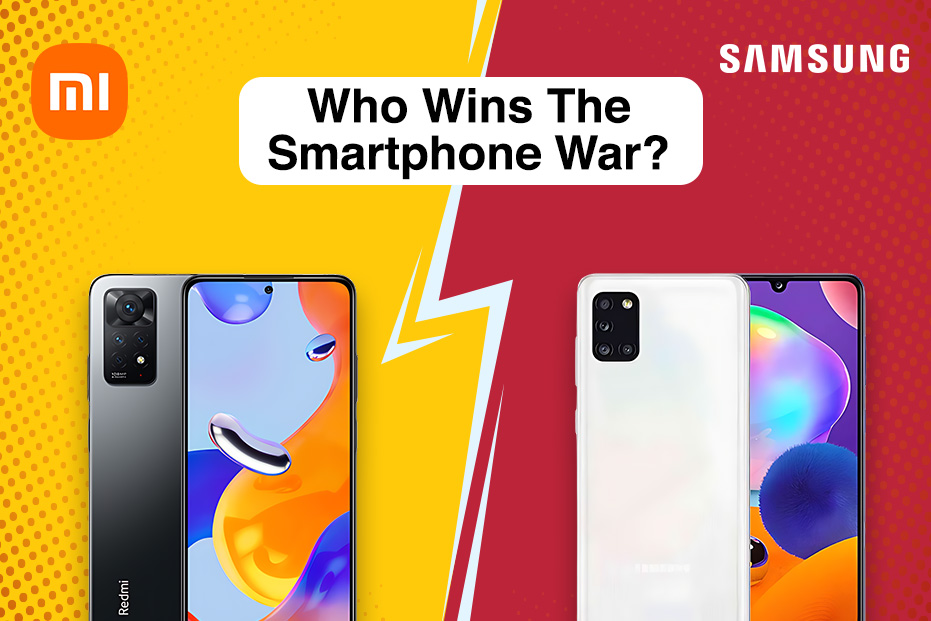The world of smartphones in Pakistan is dominated by fierce competition between two prominent brands: MI (Xiaomi) and Samsung. MI, the Chinese tech giant, has made a name for itself with its innovative and affordable devices. Meanwhile, Samsung, the South Korean powerhouse, is renowned for its cutting-edge technology and stylish designs. In this captivating article, we dive into the battle between MI and Samsung as they strive for smartphone supremacy. Join us as we explore their features, performance, and value and discover which brand emerges victorious in this epic smartphone war!
Design And Build Quality
When it comes to design, Xiaomi and Samsung have their own unique styles. Samsung goes for a premium look with angular designs, while Xiaomi opts for attractive colors and elegant designs. Xiaomi and Samsung are committed to providing smartphones with solid build quality and durability. Samsung, renowned for its premium devices, invests heavily in materials and craftsmanship to ensure sturdy and long-lasting construction. Their devices often incorporate high-quality materials such as glass and metal, giving them a solid and robust feel. Similarly, Xiaomi’s smartphones also boast reliable build quality. They prioritize using durable materials that can withstand daily wear and tear. Xiaomi understands the importance of creating devices that can endure the rigors of everyday use, delivering a satisfying tactile experience for its users.
Performance and Hardware
When it comes to performance, MI and Samsung smartphones deliver impressive capabilities that cater to the needs of tech-savvy users. Let’s take a closer look at what makes these brands true powerhouses. Comparing processors, MI and Samsung showcase their technological prowess. Samsung often incorporates their in-house Exynos or Qualcomm Snapdragon processors, known for their speed and efficiency. MI devices, on the other hand, predominantly feature Qualcomm Snapdragon processors, renowned for their strong performance and seamless multitasking abilities. RAM and storage options vary across their lineup, allowing users to choose devices that meet their specific requirements. Both brands offer a range of RAM capacities (ranging from 4GB to 16GB), ensuring smooth operation and efficient multitasking. Storage options also vary, with budget-friendly models offering modest capacities and flagship devices providing generous storage space. Additionally, expandable storage through memory cards is a common feature, allowing users to increase their storage capacity as needed. Quality displays, cameras, and other hardware features also contribute to the overall smartphone experience. Samsung excels in display technology, with their Super AMOLED panels offering vibrant colors, deep blacks, and excellent contrast ratios. On the contrary, MI offers AMOLED and LTPO OLED displays in their premium devices that deliver good color accuracy and immersive visuals. Both brands incorporate advanced camera systems, providing excellent image quality and versatile shooting capabilities.
Software and User Experience
MI and Samsung offer distinctive user experiences through their software skins. Samsung’s OneUI boasts a visually appealing design with additional features like extended multitasking and S Pen stylus support. Native integration with Samsung services enhances the overall user experience. Meanwhile, Xiaomi’s MIUI provides a sleek and highly customizable interface, allowing users to personalize their smartphone experience to a greater extent. In terms of software updates and support, Samsung has extended its update policy, offering timely updates and security patches for high-end models and increasing the duration of their support. Xiaomi, however, has faced challenges with MIUI updates, with the latest version limited to a few devices and a delayed upgrade to Android 13. Moreover, they offer updates and security patches for a shorter duration than Samsung. The overall user experience of Samsung’s devices is enhanced by minimal bloatware and seamless integration with its hardware ecosystem. On the other hand, Xiaomi has faced criticism for the presence of ads and pre-installed bloatware on its devices.
Pricing And Value For Money
MI and Samsung have different pricing strategies that cater to different market segments. By comparing their offerings, it becomes clear how they position themselves in terms of price and value. MI is known for its competitive pricing, offering devices that strike a great balance between features and affordability. The brand’s focus on delivering innovative technologies at accessible price points has resonated with budget-conscious consumers. Xiaomi’s approach emphasizes getting the most value for your money, allowing users to enjoy a wide range of features and performance without straining their wallets. On the other hand, Samsung positions itself as a premium brand with a wider range of pricing options. While their flagship devices may have a higher price, Samsung justifies the cost by emphasizing cutting-edge technology, refined design, and premium materials. They target users who desire top-of-the-line features and an exceptional smartphone experience.
Which Is Better: MI Or Samsung?
In the competitive world of smartphones, both brands stand out with their distinct approaches. MI offers affordability and innovation, striking a balance between features and price. Samsung caters to those seeking premium quality, cutting-edge technology, and an elevated smartphone experience. If you plan to purchase your next Samsung or MI smartphone online but have a tight budget, visit KalPay Rasayi’s website. We offer a convenient Buy Now, Pay Later service that you can use to shop online in affordable 3 monthly installments without any interest.



Leave a Reply